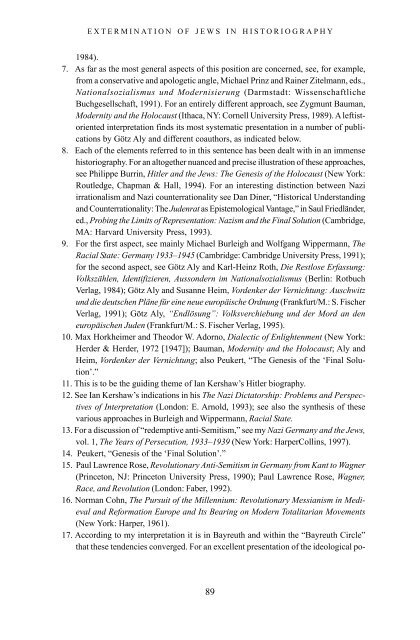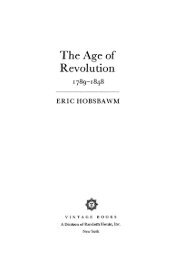The_Holokaust_-_origins,_implementation,_aftermath
The_Holokaust_-_origins,_implementation,_aftermath
The_Holokaust_-_origins,_implementation,_aftermath
You also want an ePaper? Increase the reach of your titles
YUMPU automatically turns print PDFs into web optimized ePapers that Google loves.
EXTERMINATION OF JEWS IN HISTORIOGRAPHY<br />
1984).<br />
7. As far as the most general aspects of this position are concerned, see, for example,<br />
from a conservative and apologetic angle, Michael Prinz and Rainer Zitelmann, eds.,<br />
Nationalsozialismus und Modernisierung (Darmstadt: Wissenschaftliche<br />
Buchgesellschaft, 1991). For an entirely different approach, see Zygmunt Bauman,<br />
Modernity and the Holocaust (Ithaca, NY: Cornell University Press, 1989). A leftistoriented<br />
interpretation finds its most systematic presentation in a number of publications<br />
by Götz Aly and different coauthors, as indicated below.<br />
8. Each of the elements referred to in this sentence has been dealt with in an immense<br />
historiography. For an altogether nuanced and precise illustration of these approaches,<br />
see Philippe Burrin, Hitler and the Jews: <strong>The</strong> Genesis of the Holocaust (New York:<br />
Routledge, Chapman & Hall, 1994). For an interesting distinction between Nazi<br />
irrationalism and Nazi counterrationality see Dan Diner, “Historical Understanding<br />
and Counterrationality: <strong>The</strong> Judenrat as Epistemological Vantage,” in Saul Friedländer,<br />
ed., Probing the Limits of Representation: Nazism and the Final Solution (Cambridge,<br />
MA: Harvard University Press, 1993).<br />
9. For the first aspect, see mainly Michael Burleigh and Wolfgang Wippermann, <strong>The</strong><br />
Racial State: Germany 1933–1945 (Cambridge: Cambridge University Press, 1991);<br />
for the second aspect, see Götz Aly and Karl-Heinz Roth, Die Restlose Erfassung:<br />
Volkszählen, Identifizieren, Aussondern im Nationalsozialismus (Berlin: Rotbuch<br />
Verlag, 1984); Götz Aly and Susanne Heim, Vordenker der Vernichtung: Auschwitz<br />
und die deutschen Pläne für eine neue europäische Ordnung (Frankfurt/M.: S. Fischer<br />
Verlag, 1991); Götz Aly, “Endlösung”: Volksverchiebung und der Mord an den<br />
europäischen Juden (Frankfurt/M.: S. Fischer Verlag, 1995).<br />
10. Max Horkheimer and <strong>The</strong>odor W. Adorno, Dialectic of Enlightenment (New York:<br />
Herder & Herder, 1972 [1947]); Bauman, Modernity and the Holocaust; Aly and<br />
Heim, Vordenker der Vernichtung; also Peukert, “<strong>The</strong> Genesis of the ‘Final Solution’.”<br />
11. This is to be the guiding theme of Ian Kershaw’s Hitler biography.<br />
12. See Ian Kershaw’s indications in his <strong>The</strong> Nazi Dictatorship: Problems and Perspectives<br />
of Interpretation (London: E. Arnold, 1993); see also the synthesis of these<br />
various approaches in Burleigh and Wippermann, Racial State.<br />
13. For a discussion of “redemptive anti-Semitism,” see my Nazi Germany and the Jews,<br />
vol. 1, <strong>The</strong> Years of Persecution, 1933–1939 (New York: HarperCollins, 1997).<br />
14. Peukert, “Genesis of the ‘Final Solution’.”<br />
15. Paul Lawrence Rose, Revolutionary Anti-Semitism in Germany from Kant to Wagner<br />
(Princeton, NJ: Princeton University Press, 1990); Paul Lawrence Rose, Wagner,<br />
Race, and Revolution (London: Faber, 1992).<br />
16. Norman Cohn, <strong>The</strong> Pursuit of the Millennium: Revolutionary Messianism in Medieval<br />
and Reformation Europe and Its Bearing on Modern Totalitarian Movements<br />
(New York: Harper, 1961).<br />
17. According to my interpretation it is in Bayreuth and within the “Bayreuth Circle”<br />
that these tendencies converged. For an excellent presentation of the ideological po-<br />
89



